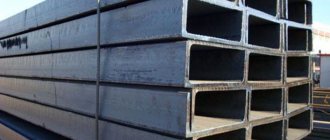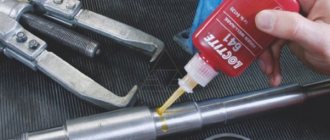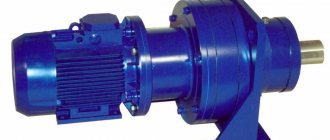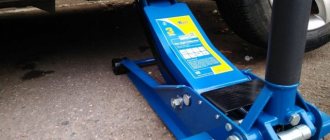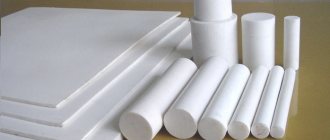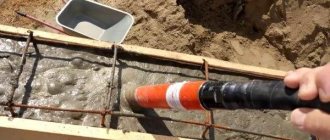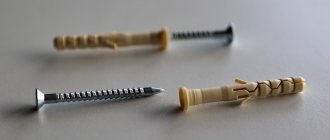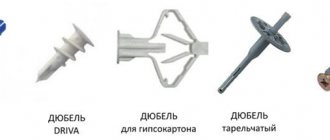Dowel concept
To be fair, the dowel is not the fastening itself, but that part of it that is inserted into the base and provides the very possibility of fastening. Its predecessor was an ordinary wooden plug - a chopik, which was driven into the walls so that it became possible to drive a nail into the base.
The dowel still plays the same role today. But, it is true, modern models offer the possibility of mounting on a wide variety of materials: heavy concrete and porous, hollow brick and dense natural stone, gypsum, drywall and loose slag concrete. The design of the product provides such wide possibilities.
A dowel is a sleeve or sleeve. The dowel itself does not form a fastening, but is firmly fixed in the wall material. An object or material is secured by screwing or driving a nail, screw or screw into the sleeve. At the same time, the sleeve changes shape - it expands, twists, folds, that is, it forms a very reliable adhesion to the base.
Installation of dowel-nails in brick and concrete foundations
In order to mount a dowel-nail into a brick, a hole of the appropriate depth and diameter is first drilled in it. To do this, proceed in the following sequence:
- begin to drill the brick using a drill set to impact approximately in its center, being careful and, if possible, at low speeds for the first 10-15 mm;
- free the resulting hole from dust and debris;
- Lightly tapping the cuff of the dowel with a hammer, drive it into the hole;
- The nail is carefully driven in with a hammer or screwed in with a screwdriver or screwdriver.
If the base is concrete, then they act a little differently:
- the hole is marked using a nail or a center punch and a hammer;
- using a percussion hammer, a hole in the concrete corresponding to the diameter is drilled, and the depth of the hole should be 5-10 mm greater than the length of the dowel;
- the hole is cleared of dust and construction debris;
- the dowel is carefully hammered into the hole;
- carefully drive the nail, and not completely, leaving a distance of 3-4 mm from its head to the cuff. This is necessary for suspension.
Specifications
One of the main parameters of any material on which physical activity is expected to be applied is its technical characteristics. For dowels, the main indicators are as follows:
the length of standard products ranges from 40 to 140 mm, in increments of 20 mm;
metal nail diameter - from 5 to 7 mm;
The diameter of the hole that should be made in the wall surface is from 6 to 10 mm. The designation of the fastener model is made up of two indicators: hole diameter and length, and looks like 6x40, 8x100, 10x100, etc.
The maximum thickness of materials that the dowel can attach is from 10 to 100 mm. This indicator is important to take into account when preparing materials for thermal insulation, since incorrectly selected fasteners may simply not reach the wall, or the location of its opening will not be deep enough.
Fasteners are produced from high-quality steel grades St 50, 60, 70, galvanized to prevent corrosion. The opening part is made from various polymer materials: polyethylene, polypropylene, polyamide. The first two materials have low resistance to negative temperatures, while polyamide is well suited for external work, for example, for thermal insulation and waterproofing of a house, installation of sheathing under siding or a block house, etc.
Criteria for choosing plastic dowels
- The material from which the walls are made.
- Weight and thickness of the dowel.
- Indicator of chemical inertness.
- Raw materials selected for production.
- Installation method.
- Indicator of permissible operating load.
- Parameters of length, diameter.
There is an additional classification.
- A non-expanding sleeve that does not change in shape or size when screwed in. It will hold the dowel in the specified position during installation. Also, this moment will prevent direct contact of the nail with the wall.
- Designed for expansion during installation. The working part, when screwed in, gradually increases in width. They can twist and be squeezed. Thus, partial deformation occurs.
On the spacer part there are elements in the form of: teeth, spikes, ailerons, protrusions, and slots must be present.
Types of dowels
In stores you can find a large selection of different dowels. But each of them is created for one purpose or another.
Universal polypropyleneThe simplest, but suitable for most types of work, including stone, concrete and brick. When screwing in the self-tapping screw, the dowel material is wound onto the metal, thereby securing the structure |
Universal expansion dowelIt is also made of polypropylene, but has special spacers, due to which it is held inside the hole |
Dowel nailAllows you to quickly and efficiently fasten windows, sheathing, skirting boards, beams, cable ducts, metal profiles, as well as plywood into concrete, stone or brick surfaces. Made of nylon or polypropylene, nail made of steel |
Drywall dowelDesigned for mounting various elements into sheets of plasterboard or gypsum fiber, as well as porous concrete. This fastener is made of plastic or metal. The second option (also called a “molly” dowel) does not require pre-drilling holes, since the tip of the metal dowel looks like a feather drill |
Nylon dowelAs the name suggests, it is made of nylon. It can be used in almost any situation and on any surface. Due to the presence of fastening antennae, the nylon dowel is securely held in the wall. Self-tapping screws for such a dowel usually have a diameter of 0.02-0.16 cm |
Butterfly dowelDesigned to perform serious installation work. This fastener can withstand enormous loads even if there are hollow walls. Made from metal |
Adjustment dowelWith its help, the sheathing is attached for future cladding. The main feature of this type of fastener is the ability to regulate (adjust) the position of the elements relative to the base to which they are attached |
Dowel-umbrellaA special type of dowels designed for installing thermal insulation made of mineral wool and polystyrene. The appearance of the fastener fully explains its name: a wide round cap, the main purpose of which is to hold the insulation against the wall. “Umbrellas” are made of both plastic and metal. But “umbrellas” are also called another type of dowels designed for working with drywall, mostly with hanging structures. This metal “umbrella” Molly is a nail with metal shoulders that are securely attached to a hollow structure, evenly distributing the load. Using this type of dowels you can easily hang any chandelier in a suspended ceiling |
Dowel clampIt looks like a loop made of plastic (nylon), with “antennae” along the edges, due to which the fastener will be held. Clamps are designed for mounting electrical wiring to the wall. Working with this type of dowel is very simple: first, a hole of the required diameter and depth is drilled, and then the required wire is simply pressed with a clamp, the edges of which are inserted into the previously drilled hole. They can also be used to attach small-diameter corrugated pipes |
Frame dowelIt is made of metal, since its area of application is very specific. Designed for installation of window and door frames. A metal frame dowel is also suitable for fastening the sheathing through a layer of plaster and thermal insulation. |
What is a dowel? Definition and purpose
A dowel is a specialized fastener designed for installation and connection of various structures. There are a huge variety of different types of dowels, each of which is suitable for a particular material: concrete, stone, drywall, wood and others.
This fastening is most often used when there is no access to the edge of the connecting rod of a conventional screw. That is, when it is necessary to make a non-through hole, for example, to install a cabinet in the kitchen or a shelf in the living room. Also, dowels are ideal for hollow walls. Other fasteners in this situation will simply be ineffective.
The principle of operation of the dowel is very simple. A dowel is a kind of buffer between the self-tapping screw and the wall, fixing the entire structure due to the presence of special ribs and “hooks”. That is, it works like a spacer.
A dowel is a cylindrical rod made of polypropylene, nylon, polyethylene or even metal. Structurally, the dowel has two parts: an expansion one - it expands during installation, securely fastening into the working material, and also a non-expansion one. Some types of dowels are equipped with a limiter cuff that prevents them from falling into the drilled hole.
Main advantages
The dowel element has a range of advantages:
- does not scroll in weakened channels;
- holds well in porous building materials;
Metal dowel for sheet materials W-GS, type Z/L - withstands significant forces without changing the initial position;
- does not allow the fastening element to fall out;
- does not become loose under alternating loads;
- easily enters building materials upon impact.
Along with increased performance characteristics, dowel fasteners are reliable and durable.
Tips and tricks
When installing dowels into a gas block, you cannot use a screwdriver, since this device runs on electricity, which makes it more difficult to control. Such a device can strip the thread by twisting the screw
When making a hole for dowels in a gas block, it is important to note that they should not be larger than their diameter. Otherwise, the fasteners simply will not hold securely in the base
The depth of the holes should be slightly greater than the length of the dowel. The tip of the screw must leave the dowel for the fastening to be as reliable as possible.
Many people, having become acquainted with dowels, begin to use them at any opportunity. However, experts do not advise using too powerful fastenings if you plan to hang hooks, pictures and other small items. For such purposes, simple plastic fasteners, the size of which is about 8 mm, are more suitable.
About fastening for aerated concrete - a nylon dowel and a metal dowel (crocodile), see the following video.
What material is the dowel plug made of?
Most fasteners are made from plastic. This is due to the low cost, availability, increased performance characteristics of the material, as well as the lack of the need to apply significant effort when screwing fasteners.
Various types of polymer materials are used for the manufacture of plastic retainers.:
- polyethylene. Easily deformable while maintaining integrity. It is lightweight and resistant to corrosion. Can be used when temperatures drop to 40 degrees below zero. Disadvantage: gradual loss of performance properties and cracking;
- polypropylene. It is used mainly indoors, as it is susceptible to negative temperatures. Advantages: increased hardness, wear resistance, and the ability to operate at high temperatures. The weak side is the appearance of cracks during long-term operation under temperature changes;
- polyamide. The material is also known as nylon. It is little subject to wear and is not afraid of mechanical stress. The nylon fastener is the most durable and reliable among other plastic fasteners.
Dowel for thermal insulation with a metal nail and thermal plug Strezzar Standard ST-M10x140 - 1
Along with plastic clamps, metal products are used :
- of stainless steel;
- galvanizing;
- alloys based on brass or bronze.
Despite the increased strength characteristics and rigidity of metal fasteners, they are inferior to plastic in their ability to deform while maintaining integrity. At the same time, the metal is able to withstand increased loads. Protective coatings significantly increase the service life of metal dowel elements.
Characteristic
Aerated concrete is rightfully recognized as one of the most practical and affordable materials. It makes durable and strong houses, as well as reliable outbuildings. However, you need to take into account that this material has a cellular structure, when faced with which you need to take into account many nuances. The main characteristic feature of this material is its fragility and pliability. Porous blocks can be trimmed or cut off the excess part without any extra effort. And we must also not forget that special fasteners are used for such a structure. Traditional fasteners, as a rule, do not adhere well to such foundations, which is why the whole point of their use is lost.
For aerated concrete, special dowels should be used. The design of such parts is a sleeve in the form of a spiral, on the surface of which there are ribs. When screwing in a self-tapping screw, the last elements become wider, so they fit firmly into the loose aerated concrete surface. This simple but effective device can easily withstand impressive loads. With the use of special dowels, home owners have the opportunity to hang heavy decorative objects of any size on the walls.
Modern manufacturers produce these types of dowels in two variations. They differ in design features.
- According to the shape of the fixation ribs. Such fasteners can be equipped with a classic helical spiral or have cone-shaped ribs. The edges of the latter may resemble spiral-like blades.
- By installation method. The dowels are either screwed into the base or driven into it. Screw-in types are considered to be the most reliable. It is recommended to use driven-in fasteners if the aerated concrete floor is planned to be equipped with a collet.
Dowel installation procedure
The procedure for installing a dowel into a brick wall consists of the following steps.
- The first thing to do is to carefully drill a mounting hole for mounting the fastener. This can be done using an electric drill or hammer drill with only drilling mode (no impact) turned on. It is important that the diameter of the drill used to perform this procedure exactly matches the diameter of the dowel itself.
- After drilling, the hole must be thoroughly cleaned of construction dust and pieces of material that have crumbled into its internal cavity. You can check how thoroughly you have cleaned the hole using the dowel itself: it should fit in without difficulty or obstacles.
- When the hole is thoroughly cleaned, you can begin work with dry tile adhesive, which must be diluted with water in the proportion specified by the manufacturer. After the adhesive mass is ready for use, it is necessary to fill the hole drilled for the dowel. You can use a rubber spatula for this, and you can push the adhesive mass into the depth of the hole using the dowel itself or an ordinary pencil. When the hole is completely filled with adhesive, you can insert a dowel into it, which should go into it all the way. After this, you need to let the adhesive composition completely harden, which is quite enough for 24 hours.
- After the tile adhesive has completely hardened, you can screw a threaded element (pin or screw) into the dowel. In this case, be sure to pay attention to the fact that screwing occurs with some force. This means that your dowel is securely fixed into the brickwork. Fasteners obtained using this simple technology are highly reliable and can withstand even significant weight loads.
You can also use this method if you need to install fasteners in a porous material (the use of concrete dowels for such structures is also prohibited). Such materials, in particular, can be gas or foam concrete, porous brick, etc. Taking into account their high popularity in the modern construction market, the choice of fasteners that could ensure reliable fastening of objects fixed on such structures is a rather serious problem.
Dowels for aerated concrete and other porous materials
Aerated concrete, unlike drywall, is voluminous and thick, but contains many voids within its structure. Multiple engagement points are required for secure fixation. Here are the main types of dowels suitable for such material.
Dowel with cutters
The sleeve is made of sheet iron. The working surface has four expanding edges, covered along the entire “body” with cutters. When screwing in the self-tapping screw, the steel teeth seem to “bite” into the aerated concrete and prevent the fastener from moving outward.
Dowel for aerated concrete with cutters.
For reliable installation, it is necessary to correctly select the diameter of the drill so that the dowel does not dangle in it. In this case, the four working edges with cutters will prevent rotation along the axis and will reliably open up. But the product cannot be dismantled, since the metal takes on an expanded shape and does not move back, which means the installation location must be carefully verified.
Dowel for aerated concrete with cutters in the wall.
Dowel with screw ribs
The model is marked GB. It is a plastic conical tube with a cut and solid ribs protruding along the entire structure. They are located with a slight overlap in the spiral, so they rotate slightly at the moment of driving. Due to the long, rounded ribs, the load is evenly distributed over the entire circumference and the dowel sits securely in the aerated concrete wall.
Dowel with screw ribs.
The plastic sleeve can accommodate screws with a diameter of up to 28 mm. Such elements have approval from the German building supervision organization and are suitable for preliminary or permanent installation in aerated concrete.
Dowel with screw ribs.
The length of the screw is calculated by adding the length of the dowel itself, the thickness of the mounting eye and another diameter of the screw. The element is even suitable for fixing into unplastered walls. When installing, it is important to use the drilling mode without impact, otherwise the hole will be too loose and weaken the fixation.
Metal dowel with internal thread
The dowel is made of metal and has high turns of external thread. Due to this structure, it is well retained in the porous material and resists not only shear loads, but also longitudinal effects.
Metal dowel with internal thread.
Installed in a pre-drilled hole using a hex wrench using the rotation method. For large volumes of mounting elements, it is advisable to use a screwdriver or drill at low speeds.
The dowel has proven to be resistant not only to static but also to variable loads, for example, holding shelves, shoe stands, and kitchen hanging cabinets. Since the part is entirely made of metal, it provides increased fire resistance and can be used near heating sources (it is allowed to hang heating radiators or fireplace protective screens on such dowels).
Based on the base materials, the dowel is suitable for:
- solid and hollow light expanded clay;
- solid porous concrete;
- ordinary expanded clay.
Features of using dowels
When choosing a dowel, it is not enough to focus on its shape; it is also important to know what size (length, diameter) to choose. For each working surface it is necessary to select its own fasteners. The “six” dowel (6*40) is suitable for installing profile structures in cinder block houses. By choosing a different size, it will not be possible to make repairs, since all the fasteners will simply fall out of the drilled holes.
For panel houses (as well as those where there are no voids in the walls), the best option for dowels is 6*60 or 6*80. With them, everything will be securely fastened, nothing will fall through or fall out even on the ceiling.
When choosing the length of the dowel, it is worth remembering the load that the fastener will be subjected to in the future during operation. The shorter the dowel and self-tapping screw, the less load it will withstand. The diameter is also important. For ordinary housework (hanging a cabinet, mirror or wall unit), dowels with a diameter of 8-10 mm are sufficient. The only difference is the depth of the hole being drilled, since the load on the dowel is different.
For a cabinet, 3-5 cm is enough, and for a wall unit or a heavier cabinet or shelf - 8-10 cm. Another important question that arises before the master is what kind of drill is needed for the dowel. To answer this, you first need to know what surface will be drilled and what load on the structure is planned in the future after the work is completed.
Installation methods
Drills are chosen so that their diameter matches the outer section of the dowel; more or less cannot be taken. The length of the drill should select such a passage so that the self-tapping screw, after passing through the dowel, protrudes beyond the limits. The entire surface of the dowel must be in contact with the walls.
Installation methods:
- in dense and hard materials, holes are made with a hammer drill, impact drill, or drills with impact tips;
- in porous ones like foam concrete, a drill and drill bits without a pobedite tip are used;
- to drive nails, use a hammer and hit the head;
- For screwing, take a Phillips or straight screwdriver.
If the self-tapping screw has a hexagonal head in the form of a bolt, use a wrench to tighten it.
How to choose a drill for a dowel
The most important rule is that the drill number must match the number (size) of the dowel. That is, ideally, the dowel should be driven into the wall with difficulty, otherwise, a situation is possible when the dowel simply falls out or fails. As for the quality of drills, experienced craftsmen advise using pobedit ones, since buying more expensive ones does not make much sense. Making a hole for a dowel is easy (for example, take dowel 10):
- First, take a smaller drill bit, such as an 8-point drill. Make the hole slightly smaller in depth than necessary using the impact mode.
- Then you will need a drill that is the same size as the dowel, that is, a 10-piece. Turning off the impact mode, finish the desired hole.
By following these rules, you will do everything without problems.
Advantages of plastic dowels
Plastic in the form of polypropylene, polyamide, polyethylene has the following positive qualities.
- High viscosity and elasticity.
- Resistant to corrosion.
- Resistance to moisture, water, fungus and mold.
- Reasonable price.
- Big choice.
Minuses
- If the product is made of cheap plastic, then it may have low strength.
- It will not pierce the material when screwed into the wall, just like a metal dowel.
Where are dowel nails used?
These fasteners are used to create a reliable connection in places that are difficult to reach with a screwdriver, or in cases where such a tool is not at hand. The second important reason for this choice is the speed of installation, due to which such a metal nail is significantly superior to analogues. To install these nails, you do not need to make precise markings to perfectly match the hole in the material. The nest for them is drilled directly through the attached material, after which the dowel is installed in the hole and driven in with a hammer. Such a nail for the baseboard can speed up the work several times without changing the quality of the fastening.
It is very common to use fasteners for thermal insulation of external and internal walls of a house. Features of fastening with hard materials (concrete, brickwork) allow the use of dowels and mounting nails for covering walls with facing materials or plasterboard.
Dowels designed to work with a mounting gun are very convenient for fastening metal structures to a brick, concrete or wooden base. A clear example of such work is the installation of metal canopies over balconies and windows.
Dowel classification
The classification of dowels is divided into 3 aspects. What type of installation? What is the material of manufacture? Where will it be used? Let us present the basic facts about the classification of each aspect.
- Type of installation. The installation principle of the dowel is very simple. We are not talking about deepening the screw into the surface, but installing the sleeve itself. There are 2 types of installation work. Preliminary - the fastening is fixed into the base, and the material is adjacent to it. Through - the passage of fasteners through a layer of any material or between a void.
- Material. The bushing can be made of either plastic or metal. Plastic products are several times cheaper, but they also serve for a long time and do not lose their properties. Metal dowels are coated with an anti-corrosion coating. They are reliable, but their prices are much higher.
- Application area. Of course, it is worth taking into account the surface material, but also not forgetting about the features of the fasteners and their performance characteristics. There are general purpose dowels that fit everywhere. And special - limited scope.
Tips for choosing
In the catalog from a well-known manufacturer you can find a wide variety of products. Moreover, comparative tables contain data on what depth a particular dowel should be immersed, what load it is designed for, and even how it will behave in a particular environment.
As a result, the most important thing is to find out what the builder is actually dealing with in each specific case.
Base material
In dense concrete, old concrete, aerated concrete, the same fastener behaves completely differently and can withstand different loads. So finding out what exactly the walls and ceiling in the apartment are made of is very important. This can be done using a fairly simple test: dust from a drill hole.
- Concrete is a material that offers strong resistance when drilling. Drill flour is finely ground, hard, free-flowing, the color varies from white to light gray.
- Old and stretched concrete - the color of flour is closer to gray. When drilling, “dips” are felt: the drill unexpectedly easily passes through the damaged areas.
- Foam or aerated concrete - the resistance of the material is low, the hole is larger than the diameter of the drill. The dust is light, mostly white, but coarse-grained and slightly sticky to the touch.
- Clay brick , both solid and hollow, produces reddish or yellowish dust, hard and free-flowing.
- In sand-lime brick , the flour is light, and the drilling resistance is greater.
- When drilling limestone, the dust will be white, sandy, and the resistance is average.
- Drilling into drywall produces white dust. It noticeably sticks to the channels on the drill. Gypsum fiber produces gray dust.
Even without knowing the exact brand of concrete or class of brick, this information is already enough to determine the category of dowels used.
Load nature
The most important thing here is to correctly determine the load and correctly calculate the power of the dowel. The latter is determined by the ratio of the diameter and length of the fastener.
In everyday life we most often deal with these types of loads.
- Horizontal shear - this load occurs when installing cabinets, shelves, pictures and larger structures on the wall. Fasteners are selected according to the weight of the product - from 6 to 10 mm. The length ensures fixation in the wall material. The dowel is immersed 30–50 mm into a solid base; in a loose or slotted recess it should be more.
- Vertical – the load that occurs when installing a chandelier, communications, or air conditioner on the ceiling. With the same dowel parameters, the penetration should be greater than into the wall. For example, with a diameter of 6 mm, the fastener must enter at least 40 mm into the wall, and into the ceiling - at least 60 mm.
For installation in the ceiling, you need to select a dowel with additional elements: transverse notches, spacer wings, and so on. The hole in the ceiling must exactly match the diameter of the dowel; the fasteners fit very tightly.
- Dynamic load – is formed during the use of a ladder, wall bars, horizontal bar or other sports equipment. In this case, bolted fastenings are preferable, since they are more resistant to vibration.
For greater reliability of fastening, the dowel is lubricated with PVA glue. When mounting on a ceiling, this technique is often recommended.
Features of the base and product
A special dowel has also been developed for special products. These models are not interchangeable except in special cases.
- For example, it is possible to replace the frame fastening with a facade one, since the latter also has a long non-expanding part and has a high load-bearing capacity.
- It is impossible to replace the dowel for fastening with sheet material - butterfly or molly. The products differ in the material of manufacture - plastic and metal, respectively, but have the same design: when the screw is tightened, the sleeve folds, pressing against the sheet.
- The universal dowel has a similar design, which also deforms in voids, forming a knot. However, for drywall, during its installation, this type of dowel is rarely used, since it is expensive. But when attaching to tiles or sheet steel, it is irreplaceable.
Plastic and metal dowels of the same design and purpose differ only in load-bearing capacity. They can be replaced within the same range. But if the structure being fixed is fire hazardous, only metal fasteners are allowed to be used.
- There is nothing to replace the dowel for thermal insulation - this is the only possible fastener for soft insulation.
- Obviously, you cannot use a general-purpose expansion dowel in aerated concrete: the material does not create sufficient friction force. However, fasteners for porous material are not installed in dense concrete: the shape possibilities in such a material turn out to be excessive.
Dowel is an extremely versatile fastener. Among its many types, you can find models for both solid and hollow material, for fixing heavy structures and loose insulation, for installing windows and communications.
Cost of fasteners
The price is more than affordable. It varies from eight to thirty-five rubles per piece, depending on the size and load.
There are universal models, but they are more expensive, from thirty-one to thirty-eight rubles.
General view of dowels
A dowel is an auxiliary fastener that provides fixation of the main fastening element (screw) in the load-bearing base. The use of dowels facilitates installation, increases the strength and reliability of the connection, and prevents destruction of the base material under the influence of loads on the connection.
There are three types of dowels, differing in the type of fixation at the base:
|
|
|
Dowels of the first type are fixed in the base material due to the action of friction forces. This dowel has a spacer part, which, when the screw is screwed in, expands (wedges), rests against the channel walls, and is anchored. Previously, ordinary wooden dowels acted as spacer dowels; today they are made of plastic (usually nylon, polypropylene and polyethylene of various brands). Expansion dowels best withstand shear loads, therefore they are most often used for installation on vertical surfaces (walls). They are not used for mounting suspended structures on horizontal surfaces (ceilings, consoles), as they do not resist pulling out well.
The second type of dowel is fixed by creating persistent resistance outside or inside the base material. Such fasteners are structurally designed to change the shape during installation - expansion, tying into a knot, opening of stops, etc. Due to this, the anchoring (“anchoring”) of the dowel occurs, and it cannot be squeezed out. Anchor dowels work well both for shearing and extrusion, so they are suitable for installation on vertical and horizontal surfaces, including for hanging various products from the ceiling.
Anchor dowels are divided into two groups:
- With external support - used for installation on thin-walled materials (gypsum plasterboard, fiberboard, MDF, etc.);
- With internal stop – used for installation in both hollow and solid materials.
Dowels of the third type have a design that allows them to be used both as spacers and as anchors - it all depends on the base material. When installed in solid materials, the dowel acts as a spacer, being fixed due to friction forces. When installed in hollow materials, the spacer part of the dowel is deformed (usually tied into a knot), due to which it is anchored.
There is also another type of fastening joints - adhesive or chemical anchors. These products are fixed in the material using resin or special solutions.
It is necessary to make a note about what a dowel and an anchor are:
- A dowel is an auxiliary product that can be used with a screw of suitable characteristics (diameter and length). The dowel and screw are in most cases sold separately. Typically, dowels are made of polymer materials (nylon, polyethylene), but there are also metal dowels for screwing in screws with metric threads;
- The anchor is a finished product for which there is no need to purchase additional components. Typically, anchors are made of metal, which ensures high reliability and durability of installation based on them.
In the future, we will only talk about plastic dowels, their features, types and applications.
General purpose expansion dowels
This is one of the widest groups of dowels that are used when installing furniture elements, suspended ceilings and other structures to the wall. As the name implies, fixation is carried out by expanding in the material, which means the wall must be quite dense.
Previously, instead of such dowels, wooden choppers were used. They were inserted into the drilled holes and self-tapping screws were screwed in, due to which the assembly was pulled apart and fixed. But it takes a long time to plan a chop from wood each time, so we developed expanding structures with standard dimensions for the diameter of the drills.
Description and principle of operation
For fixation, dowels of this type have moving parts that protrude outward as the screw is screwed in. The dowel itself is made of polyethylene, nylon or polypropylene. These are soft materials that are easily exposed to metal screws from the inside.
The length of the dowels can be extended, shortened or standard. There can be two, three or even four spacer blades. Some designs include a countersunk head to hide subsequent fasteners.
Expansion dowel device.
The “antennae” on the “body” of the element prevents the dowel from turning in the wall when the screw is tightened (due to a drill of the same diameter, the hole is slightly broken and without the “antennae” the plastic insert would easily rotate). The edge at the end prevents the dowel from being pushed deep into the wall.
Elements for fastening are available in standard diameters of 5, 6, 8, 10, 12,14,16 mm.
There are rare sizes of 4, 7 and 20 mm.
Difference in design
All expansion dowels have a split part, which diverges as the hardware is wrapped. The non-spacer base ensures that the integrity of the plastic structure is maintained. There may be a lip at the end to limit the insertion depth, but there are versions without it.
Expansion dowel in the wall.
All dowels in the group are also equipped with a guide cone, which ensures easier entry into the hole. According to the elements of tangential and anchor fixation, they differ into several types.
Expansion dowel with spikes
Installers call this model “chapai”. The design has serrated edges on both sides that release the fasteners in the hole. Two large spikes prevent turning until the teeth are engaged. This design is especially convenient when screwing hardware into the ceiling, when they can fall out under their own weight.
Expansion dowel with spikes.
Expansion reinforced dowel
It is most often called the “hedgehog dowel” because it has small protrusions on four sides that resemble spines. There are no long “antennae” in the design. Unlike the previous one, it expands along its entire length and is great for concrete. Due to fixation in all directions, the fastener can withstand increased loads well.
Expansion reinforced dowel.
Three-spread dowel
The model is designated as T-dowel. The spacer part contains, instead of teeth, solid, even ribs that reliably fix the fastener in the hole. The non-expandable base is equipped with conical projections that prevent the dowel from sinking into the wall. It is often used on brick and concrete to fix shelves, lamps, and paintings.
Three-spread dowel.
Application
In general, the expansion group of dowels perfectly resists shear loads, so the fasteners are optimal for walls. The weights hung on it press down, and the spacer part reliably holds the weight of up to 20-30 kg at each point. Dowels of this type are also suitable for floor installation, for example, to secure the linoleum threshold in a concrete floor. The impact from the legs is across the location of the screw axis and it does not become loose.
But when applying longitudinal force, for example, for attaching objects to the ceiling, they are not the best, since they are less resistant to pulling out. On ceilings and consoles, it is permissible to fix only light interior parts or technical devices (installation of wiring under a suspended decorative ceiling, fastening a lamp, etc.). The fixative holds well in concrete, stone, and brick.
